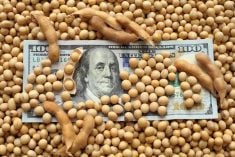Glacier FarmMedia | MarketsFarm – March 31 will be a busy day in the commodities market with the United States Department of Agriculture scheduled to release two major reports. At 11 am CDT on that Monday, the USDA will issue its grain stocks as of March 1 report along with its prospective plantings estimates for this spring.
When it comes to stocks of U.S. corn, Bryan Strommen of Progressive Ag in Fargo, ND pointed out the reduced production in 2024/25 due to lower than expected yields. In turn, that created tighter stocks which have been magnified by good export demand during the first quarter of 2025.
Read Also

China to buy 12 million metric tons of soybeans this season, Bessent says
U.S. Treasury Secretary Scott Bessent said on Thursday that China has agreed to buy 12 million metric tons of American soybeans during the current season through January and has committed to buying 25 million tons annually for the next three years as part of a larger trade agreement with Beijing.
“Brazil corn is trading at three-year highs, so U.S. corn is competitive on the world market,” said Strommen.
A survey of trade participants placed March corn stocks at 8.06 billion to 8.31 billion bushels with the average at 8.15 billion. A year ago corn was at 8.35 billon, according to the USDA.
Soybeans disappointing
As for U.S. soybeans, Strommen explained export demand has been disappointing which would account for the larger stocks expected.
Trade guesses ranged from 1.82 billion to 2.02 billion bushels with the average at 1.91 billion. A year ago they stood at 1.85 billion bushels.
Strong global wheat crop
Strommen said it’s pretty much the same story for U.S. wheat, noting there are not any major issues with the global crop, meaning “there’s plentiful stocks.”
Going into the stocks report, the trade estimated the volume of all wheat at 1.17 billion to 1.26 billion bushels, with the average at 1.22 billion. Stocks last March were 1.09 billion bushels.
More corn, less soybean acres
For the prospective plantings, Strommen highlighted the farmer’s need for cash flow for the shift of soybean acres to corn.
“If there is a weather issue, with the tighter corn stocks, corn has the better opportunity to increase … as prices go,” he said.
Ahead of the plantings report, the trade projected U.S. corn acres at 92.50 million to 96.60 million, with the average at 94.40 million. This time last year the USDA forecast 90 million acres, with the final plantings calculated at 90.60 million.
That’s to push planted soybeans acres down to 82.50 million to 85.80 million, with an average of 83.50 million. In 2024/25, 87.10 million acres of soybeans were seeded by U.S. farmers after the USDA projected 86.50 million.
No incentive to seed wheat
With U.S. winter wheat acres already determined, any shift in all wheat lays with spring wheat Strommen noted.
“It’s a higher input commodity as well. Without the opportunity for forward pricing, a disappointing board price, there’s just no incentive to (spring wheat),” he stated.
The range for all wheat came to 45.40 million to 47.10 million acres, with an average of 46.50 million. For 2024/25, 46.10 million acres were sown, down from 47.50 million initially forecast.
Lastly, Strommen commented any moves in commodities created by these reports could quickly change two days later when U.S. President Donald Trump will announce his next tariff moves.











